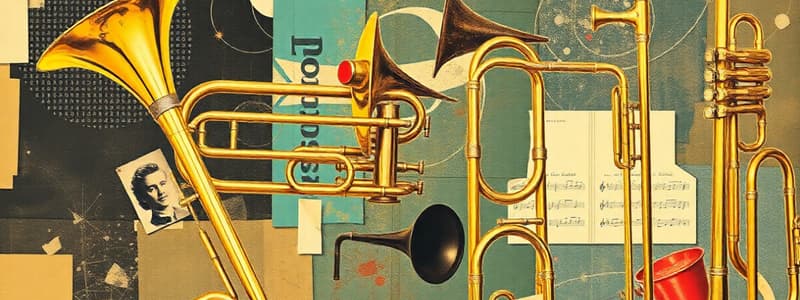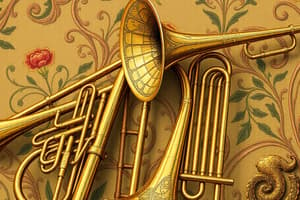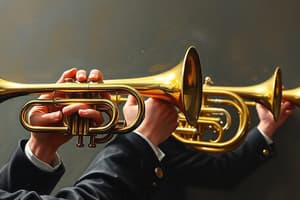Podcast
Questions and Answers
What distinguishes the trombone from many other brass instruments?
What distinguishes the trombone from many other brass instruments?
- The use of breath to produce sound.
- The presence of valves for altering notes.
- The manipulation of a slide to change pitch. (correct)
- Its origin in 15th-century Europe.
Which of the following instruments is LEAST likely to feature intricate ornamentation?
Which of the following instruments is LEAST likely to feature intricate ornamentation?
- A Shofar (correct)
- An Alpenhorn
- A Nafir
- A shell trumpet
If a musician wanted to play a complex melody with varying notes, which instrument would be the LEAST suitable choice?
If a musician wanted to play a complex melody with varying notes, which instrument would be the LEAST suitable choice?
- A shell (correct)
- A Nafir
- A trombone
- A modern trumpet
What is the primary method of sound production in a trombone?
What is the primary method of sound production in a trombone?
Which instrument has a historical association with religious practices?
Which instrument has a historical association with religious practices?
Which of the following is NOT a characteristic of the Nafir?
Which of the following is NOT a characteristic of the Nafir?
What key feature allows many brass instruments to play a wide range of notes and when was it added?
What key feature allows many brass instruments to play a wide range of notes and when was it added?
Flashcards
Brass Instruments
Brass Instruments
Long hollow tubes that produce sound when blown into.
Trombone Playing Technique
Trombone Playing Technique
Players buzz their lips into the mouthpiece to create vibrations for sound.
Shell Instruments
Shell Instruments
Simple musical instruments made from shells, producing usually one note.
Trombone History
Trombone History
Signup and view all the flashcards
Shofar
Shofar
Signup and view all the flashcards
Nafir
Nafir
Signup and view all the flashcards
Alpenhorn
Alpenhorn
Signup and view all the flashcards
Study Notes
Brass Instruments
- Brass instruments are long, hollow tubes
- Many have metal mouthpieces
- Valves were added in the 19th century, increasing the usable range of notes
How to Blow a Trombone
- Trombone players buzz their lips
- Air is blown into the mouthpiece
- This vibrates the air inside
Shells
- Shells were used as musical instruments around 4000 BCE
- They are elaborately decorated
- Some used stones
- Usually produce a single note
Trombone
- A trombone's length can be altered to change pitch, using a slide
- Invented in Europe in the 15th century
Shofar
- Used in Jewish religious ceremonies
- Made from a ram's horn
Nafir
- A brass trumpet
- Used in some Muslim countries to signal the end of Ramadan
- Made in sections for easy transport and storage
Studying That Suits You
Use AI to generate personalized quizzes and flashcards to suit your learning preferences.




